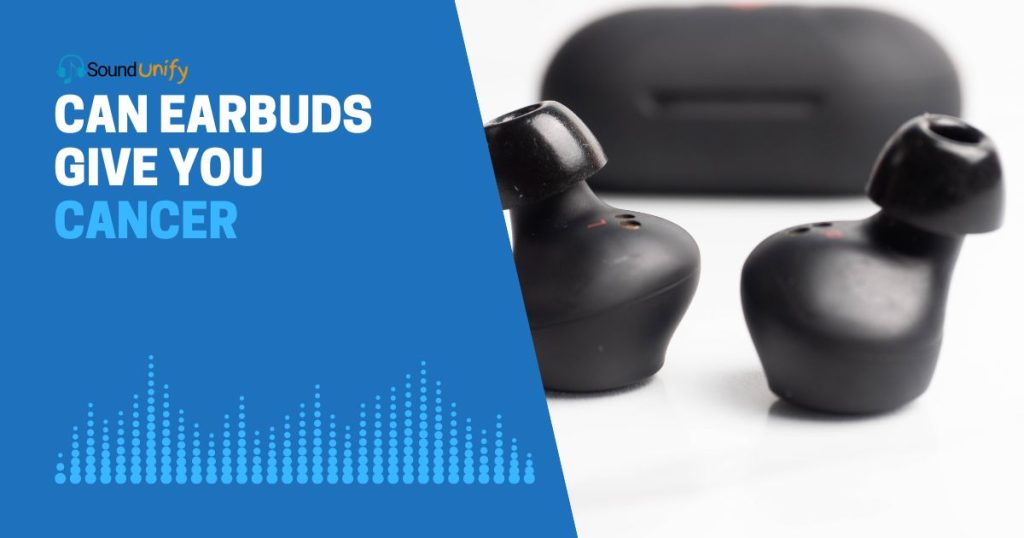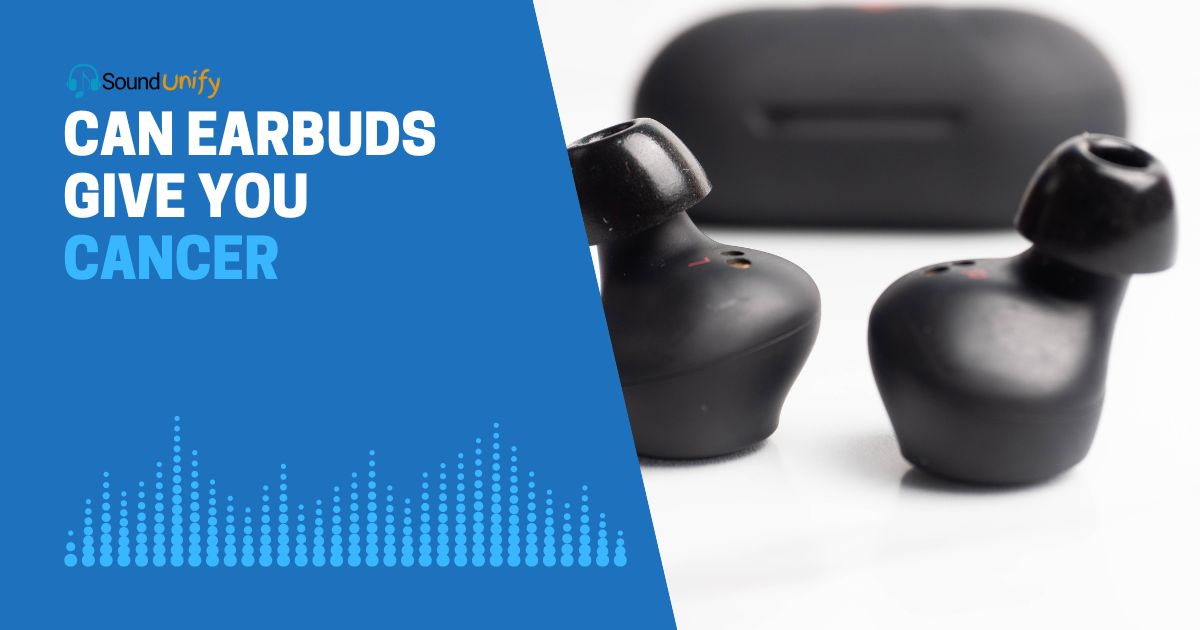No, earbuds cannot directly cause cancer. There's no scientific evidence to support this claim.
I’m sure you’ve stumbled upon this post because, like me, you’ve heard the alarming rumour: “Can earbuds give you cancer?” It’s a question buzzing around, causing quite a stir.
In our tech-savvy world, earbuds are practically an extension of our bodies. They’re our companions during workouts, solace in noisy commutes, and aid in focusing on work.
But with their constant presence comes a nagging worry. Are these tiny devices secretly harming us?
The fear of cancer is real and valid. It’s a disease that has touched many of our lives, and the thought of our beloved earbuds being a potential cause is unsettling.
But before we let fear take over, let’s delve into the science, dispel the myths, and uncover the truth together.
So, stick around because we’re about to embark on an enlightening journey.

What are Earbuds?
Before we go to the main topic, we should know about earbuds. As someone who enjoys music and podcasts, I find earbuds essential to my daily life. But what exactly are earbuds? Let’s dive into the details.
Earbuds: A Definition
Earbuds, or in-ear headphones, are small devices inserted into the ear canal to deliver sound directly to your ears. They’re compact, portable, and offer privacy that traditional speakers can’t provide.
Components of Earbuds
Earbuds may look simple on the outside, but they contain several key components that work together to produce sound:
- Driver: This is the heart of the earbuds. It’s a small speaker that converts the electrical signal from your device into sound. The driver consists of a magnet, a voice coil, and a diaphragm.
- Cable/Wireless Receiver: Wired earbuds have a cable that transmits the electrical signal from your device to the driver. On the other hand, wireless earbuds have a built-in receiver that picks up a Bluetooth signal from your device.
- Ear Tips: These are the parts that you insert into your ears. They’re usually made of soft materials like silicone or foam for comfort. Ear tips come in different sizes to fit different ear canals.
Types of Earbuds
There are two main types of earbuds: wired and wireless. Wired earbuds connect to your device through a cable, usually ending in a 3.5mm jack.
On the other hand, wireless earbuds connect to your device via Bluetooth. Some wireless earbuds have a charging case, providing extra battery life and a convenient storage solution.
Why Use Earbuds?
Earbuds offer several advantages. They’re portable, allowing you to enjoy music or podcasts on the go. They’re also great for private listening, whether you’re in a crowded place or don’t want to disturb others.
However, it’s important to use earbuds responsibly. Listening to audio at high volumes can damage your hearing over time.
I recommend following the 60/60 rule: keep the volume under 60% and take a break every 60 minutes.
The Connection Between Earbuds and Cancer
As a frequent user of earbuds, I’ve often wondered about the potential health implications. One question that often comes up is: Can earbuds cause cancer? Let’s delve into this topic and examine the facts.
Understanding Radiation
Wireless earbuds, like all Bluetooth devices, emit a type of radiation known as non-ionizing radiation.
This differs from ionizing radiation, the harmful radiation we often associate with nuclear power plants and medical imaging machines.
Non-ionizing radiation is generally considered less harmful because it doesn’t have enough energy to ionize atoms or molecules or damage the DNA inside cells.
Bluetooth and Radiation Exposure
Bluetooth operates at microwave frequencies in the 2.4 to 2.485 GHz range. While this is a form of radiation, it’s important to note that it’s at the very low end of the electromagnetic spectrum.
The power output of Bluetooth devices is also very low, typically around 1 milliwatt.
What Does the Research Say?
The World Health Organization (WHO) states that, based on current research, no adverse health effects have been established as being caused by mobile phone use, which includes Bluetooth devices like wireless earbuds.
However, some studies suggest long-term exposure to low-level non-ionizing radiation could have health effects.
It’s important to note that these studies often involve exposure levels much higher than you would get from wireless earbuds.
The Verdict
At present, there is no conclusive scientific evidence to suggest that using earbuds can cause cancer. The radiation emitted by wireless earbuds is far below the level that could cause harm to humans.
However, as with anything, using earbuds in moderation is always a good idea. If you’re concerned about radiation exposure, consider using wired earbuds, which do not emit radiation.
Health Risks Associated with Earbuds
As an avid user of earbuds, I’ve often wondered about their potential health risks. While cancer risk is a concern for some, other health risks are more commonly associated with earbuds.
Let’s take a closer look at these risks.
1. Noise-Induced Hearing Loss
One of the earbuds’ most common health risks is noise-induced hearing loss (NIHL). This can occur when you listen to music at high volumes for extended periods.
Volume and exposure time are the two key factors in NIHL. Any noise louder than a vacuum cleaner at 75dB (SPL) can threaten your hearing.
2. Ear Infections
If earbuds are left too long, it can lead to health problems such as ear infections. The ear canal is a delicate area, and prolonged use of earbuds can lead to infections in this area.
3. Potential Risks of EMF Exposure
While the risk is low, some scientists have warned that chronic exposure to electromagnetic fields (EMF), such as Bluetooth earbuds, could lead to health issues.
These potential health risks include cancer, genetic damage, neurological disorders, learning and memory deficits, and reproductive issues.
4. Motion Sickness
Some people report experiencing dizziness, motion sickness, or vertigo when using headphones, especially those with active noise canceling (ANC) features.
This is because the lack of external noise can confuse your brain and throw off your balance.
5. Tinnitus
Tinnitus, a condition characterized by a constant ringing or buzzing in the ears, can be an indirect result of damaging noise exposure, something that’s easily achieved with headphones and earbuds. It’s another reason to keep the volume down.
Safety Measures When Using Earbuds
As someone who enjoys earbuds, I understand the importance of using them safely to protect my hearing and overall health. Here are some safety measures that you can take when using earbuds.
1. Follow the 60/60 Rule
The 60/60 principle advises limiting your music to 60 percent of the maximum volume for no more than 60 minutes daily. This is because loud noises can potentially inflict irreversible damage to your inner ears, leading to possible permanent hearing loss.
2. Avoid Listening to Music at 85 Decibels (dB) or Higher.
A decibel is a unit that measures sound intensity. Normal conversation is around 60 dB, whispers are 30, while ambulance sirens range from about 100 dB to 105 dB.
The Occupational Safety and Health Administration (OSHA) has guidelines stating that anyone exposed to 85 dB for eight hours or more must legally be provided with and wear protection, as this can lead to hearing loss.
3. Don’t Shove Your Earbuds in Too Far
Earbuds are designed to be inserted safely into the ear canal. If you push the earbud too far, you risk damaging the ear canal’s skin and potentially developing an outer ear infection.
4. Clean Your Buds Regularly
While it’s uncommon for healthy individuals to contract an ear infection from earbuds, preventing them from becoming dirty is crucial. They should be wiped down and sanitized at least once a week.
5. Stay Aware While Wearing Headphones
Whether commuting to work or jogging in the park, staying aware of your surroundings is vital. Listening to music can dull our other senses, making us less responsive to auditory, visual, and tactile cues that help us stay safe.
FAQs
Can the radiation from wireless earbuds cause cancer?
There is currently no conclusive evidence to suggest that the low-level non-ionizing radiation from wireless earbuds can cause cancer.
What are the health risks associated with earbuds?
The main health risks associated with earbuds are hearing loss from prolonged exposure to loud music and ear infections from sharing earbuds.
How can I use earbuds safely?
Use earbuds safely, limit your usage, keep the volume safe (no more than 60% of the maximum), and consider using wired earbuds over wireless ones.
Are wired earbuds safer than wireless ones?
Wired earbuds do not emit radiation and generally deliver better sound quality, making them a safer and more reliable choice.
Can I get an ear infection from sharing earbuds?
Yes, sharing earbuds can lead to ear infections as bacteria can easily transfer from one person’s ear to another.
Final Thoughts
There’s currently no evidence to suggest that earbuds can cause cancer. While earbuds emit a small amount of electromagnetic radiation, it’s significantly lower than a cell phone. And studies have found no definitive link between cell phone use and cancer.
However, if not used responsibly, earbuds can pose other health risks, such as noise-induced hearing loss and ear infections.
So, while the fear of cancer from earbuds shouldn’t be a major concern, using them safely and responsibly is still important.
James Dimento is a Chief-in-Editor of SoundUnify. He is a headphone enthusiast and creative writer passionate about audio technology. He has three years of experience writing about headphones and sound quality and is responsible for creating reviews and taking care of all administration.
